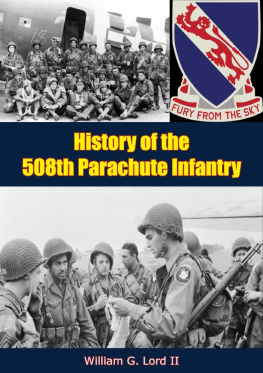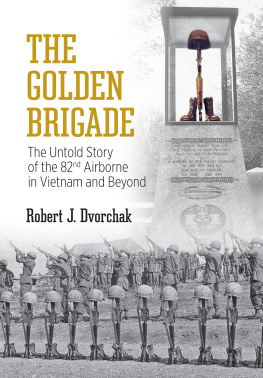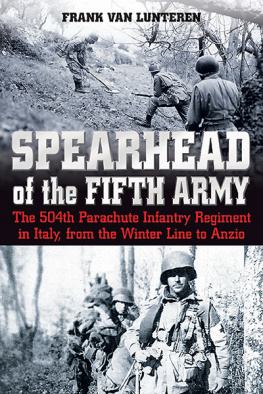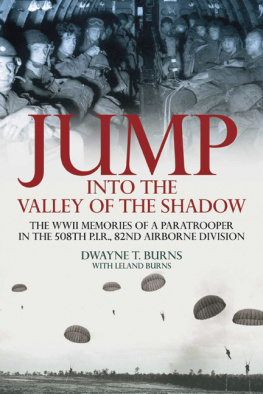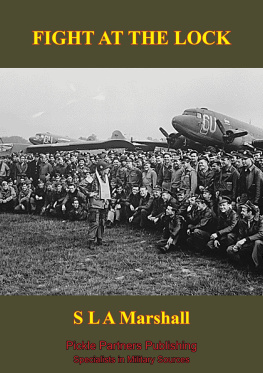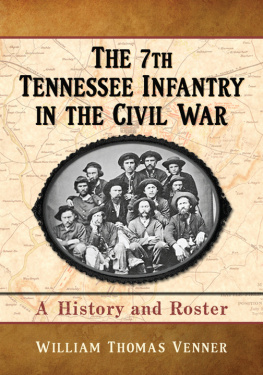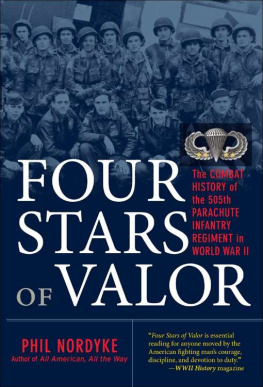This edition is published by Arcole Publishing www.pp-publishing.com
To join our mailing list for new titles or for issues with our books arcolepublishing@gmail.com
Or on Facebook
Text originally published in 1948 under the same title.
Arcole Publishing 2018, all rights reserved. No part of this publication may be reproduced, stored in a retrieval system or transmitted by any means, electrical, mechanical or otherwise without the written permission of the copyright holder.
Publishers Note
Although in most cases we have retained the Authors original spelling and grammar to authentically reproduce the work of the Author and the original intent of such material, some additional notes and clarifications have been added for the modern readers benefit.
We have also made every effort to include all maps and illustrations of the original edition the limitations of formatting do not allow of including larger maps, we will upload as many of these maps as possible.
HISTORY OF THE 508 TH PARACHUTE INFANTRY
BY
WILLIAM G. LORD, II
TABLE OF CONTENTS
Contents
TABLE OF CONTENTS
DEDICATION
TO THE MEMBERS OF THE REGIMENT
WHO FELL AND NOW REMAIN
ON THE BATTLEFIELDS OF EUROPE
MAPS
1. FLIGHT PLAN FOR THE NORMANDY DROP
2. THE NORMANDY DROP ZONES AND THE BEACHES
3. FROM STE. MRE EGLISE TO LA HAYE-DU-PUITS
4. HILLS 131 AND 95
5. FLIGHT PLAN FOR HOLLAND
6. THE HOLLAND DROP ZONES
7. THE 1ST BATTALION AT DEN HEUVEL
8. THE COUNTERATTACK AT DEN HEUVEL
9. NIJMEGAN AND THE CROSSING OF THE WAAL
10. THE TWO-MAN RECONNAISSANCE PATROL
11. THE REGIMENT ARRIVES IN THE ARDENNES
12. THE COUNTERATTACK FROM VIELSALM
13. THE ATTACK ON COMTE
14. THE ADVANCE TO LOSHEIM
15. THE DRIVE TO THE ROER
FOREWORD
In this book is written the history of the 508 th Parachute Infantry from October 20, 1942, to January 1, 1946.
As this history is read, the reader cannot fully realize or appreciate from the contents of its pages the full measure of loyalty, devotion to duty, and sacrifice of the more than ten thousand officers and men carried on the rolls of the Regiment during the past three years. No task undertaken and no mission assigned was ever too small or too great, and the result was always a prompt, enthusiastic, successful accomplishment in a superb manner.
The American soldier has again proven himself to be among the worlds finest fighting men. It is a recognized fact that the American paratrooper is peerless among men. His self-reliance, courage, aggressiveness, indomitable fighting spirit, and combat skill were exemplified by all his actions and are depicted in the following chapters for those of this Regiment.
This volume might be considered a monument to those fighting men of the 508 th who through their heroic acts and valorous deeds contributed their full share toward winning the victory that is now ours.
ROY E. LINDQUIST
Colonel, Infantry
Commanding
PART ONE: PRELUDE TO COMBAT
ON the 20 th of October, 1942, the 508 th Parachute Infantry was born at Camp Blanding, Florida, This date, however, in no way marked the beginning of the formation of a new regiment in the United States Army, for since early in September Major Roy E. Lindquist had been laying plans for the activation of the unit he was to command.
The cadre for the 508 th came almost entirely from three sources; the 502 nd Parachute Infantry, the Parachute School at Fort Benning, and the 26 th Infantry Division. Every officer and man who became a part of the cadre was personally screened by Major Lindquist. Before they could be expected to tram recruits, these officers and men had to satisfy the major that they were thoroughly versed in matters military, and so special training was given the cadre at Fort Benning. Not all of the cadre had qualified at the Parachute School, but in each mind was imbedded the belief that the parachutist in the U.S. Army was the best soldier in the world, and it was around this belief that the morale of the new outfit was to be built.
On the 20 th of October at Blanding troop trains began to arrive bringing the regimental commander, now a lieutenant colonel, and his first recruitsmen who had been in the Army only a few weeks and who had volunteered for parachute duty. The average age of the new arrivals was low, under twenty. Most were in excellent physical and mental shape, and those that werent were immediately transferred. For six weeks the processing of the new men went on, and the Regiment was built up to full strength, battalion by battalion. By the middle of December the regimental strength was 2300 officers and men, but 4500 had to be processed before this number was accepted.
The first days in Camp Blanding were almost a repetition of what had gone on in the reception centers with the very noticeable difference of a tightening of discipline. There was the thorough physical exam, the drawing of equipment, and the innumerable shots with the huge hooked needle. In addition there was the comprehensive program of physical training, consisting of calisthentics, tumbling, rope-climbing, and running. Every time there was a spare moment, it became normal procedure to run a mile. Soon it was hard to convince the men that they werent training for a track meet.
As well as the physical sorting of candidates for the Regiment, a board of officers was set up in each battalion to determine the mental fitness of every man. Sometimes it became difficult for the new arrivals to realize that they were to form a regiment of rough-and-tumble parachutists. Major Louis G. Mendez, Jr., commanding the 3 d Battalion, tested the mental alertness of his men by firing questions at them in rapid succession: What is your name? Why? Is Mickey Mouse a boy or girl? Lift your left foot off the ground. Lift your right foot off the ground. Lift both feet off the ground. By the time the interview was over, the recruit was not sure exactly what he had gotten himself into.
After these first active days, life in the Regiment settled down to a steady grind of hard work. From six in the morning till six in the evening the men of the 508 th trained. A typical work day started at 0730 after breakfast and general clean-up of barracks. A half-hour run was followed by calisthenics at which Lieutenant Fleming presided. Addressing his attention to a battalion at a time, Lieutenant Fleming got more work out of the men in half an hour than most had believed it possible to accomplish in a week. His bellowing voice made a public-address system unnecessary and gave each man the idea that he was being watched personally by the huge man on the platform, as physical maneuvers unknown even to a yogi were attempted. The rest of the morning was spent doing close-order drill, the manual of arms, and listening to lectures on military subjects.





